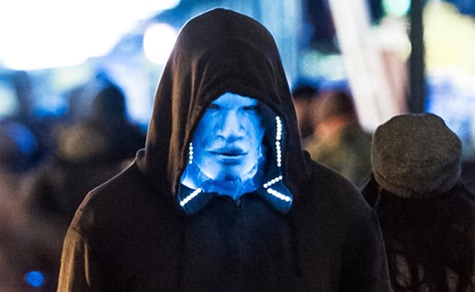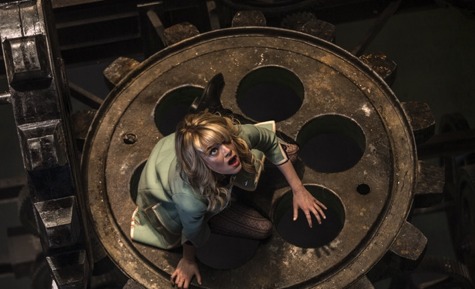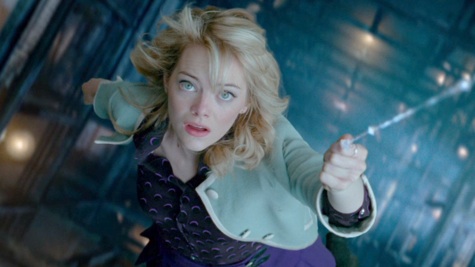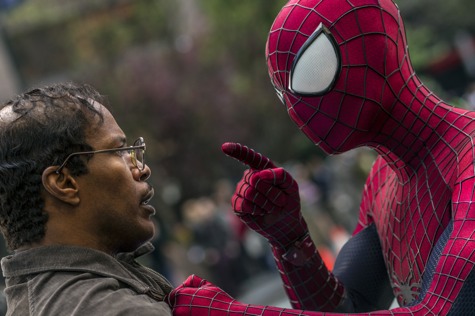The release of Captain America: The Winter Soldier hit the world like a hopeful harbinger of blockbusters to come; while we certainly have a long way to go in terms of inclusive entertainment, to have a superhero who is associated with all that is “great and good” call a team together than consists primarily of women and people of color to restore balance to the world was a welcome sight. It showed moviegoers that their calls were being noticed, that perhaps we could expect a more diverse landscape going forward. But that was one movie and one studio and one creative team, and not every story will pass muster. Which brings us to the next big summer release, in the form of a Spider-Man sequel.
What could have been an easy sell resorted to a lot of the same played-out tropes we’ve been witnessing for decades. But what was perhaps most disappointing about The Amazing Spider-Man 2 was how these tropes were displayed as though they were something fresh and new.
SPOILERS AHEAD.
Having Jamie Foxx take on the role of Electro was exciting at first blush. Foxx had never nabbed a role in a superhero yarn, and with several award-garnering performances under his hat it was great to see him come aboard. Add in some smart scripting and good framing devices and his turn as Max Dillon could have landed with the same sort of gravitas that Alfred Molina lent to Doc Ock in 2004 (a character that should have come off as utterly ridiculous and magically didn’t, even in a camp-coated Sam Raimi sojourn).
But for the first hour or so of the film, Dillon is played as a joke. He has all the bumbling ticks and pathetic neediness of Guy Pearce’s Aldrich Killian in the opening scenes of Iron Man 3, but he isn’t nastily snubbed by the Tony Starks of their world—he’s simply ignored by them. What’s more, his mad obsession over his brief meeting with Spider-Man is also played off lightly, as though it’s cute or amusingly weird. Even though there is nothing particularly funny about feeling so insignificant that you build your entire sense of self-worth around one fleeting moment you shared with your city’s web-slinging superteen. Dillon’s problems are serious psychological ones, born out of years of neglect—and we’re encouraged to laugh at them without consideration.
But what’s wrong with laughing at a good villain? This is a common way of unpacking truly odious characters in comic books, especially on Spider-Man’s side of the tracks. And perhaps that would have been fine were it not for the other aspect of Dillon’s narrative; when he finally becomes Electro, we are meant to take him seriously, to brush aside his clownish introduction and latch onto his real grievances. And those grievances have some clear racial undertones, specifically Dillon’s pain at being rendered invisible throughout his life. His erasure is a very faint reflection of the erasure of many people of color throughout the history of the world, and making that the core of Electro’s story might have been impactful… but the film flat-out refuses to engage the idea with a straight face.

This is mainly due to refusing Max Dillon any true nemesis in the film, a person he can rightfully focus his personal hurt on. He focuses it on Spider-Man, but he’s wrong to do so, and the film makes that clear in no uncertain terms. So who should Dillon be blaming? Shouldn’t there be a face, a name? He has one smarmy supervisor at Oscorp who insists that he stay at work on his birthday, but who is really responsible here? Who took Max’s genius work out from under him and slapped their name across it? Where is this vile corporate weasel?
And no, we can’t just say Oscorp at large, throw our hands up and be done with it. Why? Because that is one of the biggest problems with tackling the topic of racism itself—the refusal to give it a face. Saying, well, it was an organization. A scary group. The current zeitgeist. And by doing that, we let everyone today feel comfortable with their own privilege, by giving them this assurance they cannot possibly be contributing to it. Because big scary overlords allow things like this. Boards of Directors. Councils. By preventing Max Dillon from having any individuals to cite in his life-long battle against invisibility, we remove our own culpability from this system of erasure. It’s not our fault that Max Dillon didn’t get ahead in life! He’s goofy and needs to grow a backbone. No one is responsible for that but him.
This comes off worse when we realize that the only people Dillon is ever capable of allying himself to during the film are white men. First it’s Spider-Man, and once he’s put off the hero, it’s Harry Osborn who comes to his rescue. Electro rightly asks the kid why he should help him, and Harry begins by claiming he’s the only one who can break him out of the asylum where he is imprisoned. But once the chips are down and the fighting starts, Harry begins wailing. He assures Max through some emotional tears that he can relate to his plight—specifically that he knows what it’s like to be thrown out and cast aside.
Thing is, we know who’s responsible for Harry feeling this way. There is a direct line of causality here, running right back to Norman Osborn. And as a result, in that moment, we don’t feel for Electro—we feel for Harry. Spoiled, privileged Harry Osborn, who has had it rough, sure, but by no means as hard as a man like Max Dillon. Yet it is easier to feel for the kid because we know who hurt him. We can put a face to that torment.
So Max Dillon runs off to do the bidding of a rich white kid while we scratch our heads. That is the majority of his plot. The rest is all action-y window dressing.

This is all damning enough for the film on its own… and that’s before getting around to Gwen Stacy.
There were clues from the beginning that Gwen was for the ax, very specifically a costuming choice that the majority of comic book fans would recognize at once—her purple skirt and top combined with the blue overcoat and high boots were modeled after the exact clothes she wore on the infamous “Night Gwen Stacy Died,” noted in comics canon for being the first time a major character death was rendered with unapologetic finality. It shocked readers. It changed the rules of superhero comics. It made these worlds seem a little less safe.
Does this mean that the incident bears repeating on film? I’m not sure I have an answer to that, but how you choose to render such a defining moment will surely color your movie as a complete work. And with all that in mind, The Amazing Spider-Man 2 managed to reassert a needless cliché that popular media continues to perpetuate ad nauseam—namely that every woman who takes a risk must be punished for it.
It can be found in the most mundane of places, in stories we have been telling for centuries and longer—Jack goes up a beanstalk and is rewarded with riches beyond his wildest dreams; Little Red Riding Hood strays from the path and gets eaten by a wolf until a woodsman comes to free her from his belly. A young mermaid gives her heart to a prince and dies when he doesn’t return her affections; a young thief finds a magic lamp and gets a princess and a kingdom of his own. The female superheroes who belonged to the first generation of Minutemen are respectively raped and murdered; Padmé Amidala risked forbidden love with a Jedi only to have him turn to the Dark Side and kill hundreds of children; Jessica Atreides went against the plans of the Bene Gesserit and watched her family crumble around her. But Harry Potter defeats Voldemort while breaking every rule; the Doctor saves universes and species and planets by deliberately never doing what he’s told; Captain Kirk wouldn’t have a career without his favorite motto, “Risk is our business.” Exceptions exist but by and large, these are the stories we tell.

Peter Parker enters a lab that he shouldn’t have access to, gets bitten by a spider, and becomes a superhero who regularly saves his city. Gwen Stacy says, “I can help you this time Peter, I will save the city with you, it is dangerous but it is my choice and you have to respect my choices.”
She dies.
And some people will still think this is good enough, because when Gwen Stacy died on paper, she died as a woman who needed saving, not as an active hero in her own right. But you know what would have been braver? To have dressed her in the clothes she died in and then turned around to say: We believe that this character, this woman, matters more than a single famous moment in comics history that happened over 40 years ago. We believe she has proved herself worthy of our respect and recognition beyond her ability to die. Beyond her ability to teach harsh life lessons. Beyond her ability to provide hope and new resolve for the man who loved her. We believe she is a hero on her own merits, deserving of a hero’s story.
We believe in Gwen Stacy’s right to live.
To have done that, to have allowed Gwen to walk away from that fight while wearing the clothes she had canonically died in would have been a stunning slap-in-the-face move. And it would have forever altered these conversations. Because you know why this death stings, perhaps more than it did in 1973? It’s because between Peter dwelling on her father’s last words and his own feelings of impending doom, all it did was make the men in Gwen’s life right. Made them right to want her home, safe and sound, made them right to be overprotective watchdogs who attempted to remove her choices and push her life onto the path of least resistance and danger. It made it okay for them to try and control her, because in the end, if she had only listened she would still be alive.
And that’s not a good enough reason to rehash the lesson Gwen’s death was originally meant to teach, that superheroes can’t save everyone, that sometimes they lose. Peter has already lost someone—Uncle Ben was his price. Forcing him to lose Gwen, too, is just a reason to sulk for six months. Sulk until he’s finally reminded by her atrociously-written off-topic high school graduation speech that she can still give him hope at least.

Women are great at giving people hope, right?
You know what would have been great? If after the dust had settled, a very alive Gwen had gone to Oxford and Peter had stayed in New York. (The city does need him, after all.) And while Gwen was away, this new girl named Mary Jane Watson popped up, and he started feeling torn. Because Peter Parker is nineteen, and that is about the level of relationship drama you can manage at nineteen. None of this, “my last girlfriend died, so I will feel forever guilty about any new girlfriends” crap. Just good old-fashioned teenage angst alongside world-saving. But we can’t let Peter Parker have real people problems, didn’t you know? He’s a superhero. We go big or go home.
Even if it means we have to erase the stories of anyone not wearing the spandex.
Additional note: There seems to be some aggravation resulting from the suggestion that Max Dillon’s story has racial overtones simply because he is a black man. As was very helpfully pointed out in the comments, Max Dillon refers to himself as “The Invisible Man” throughout the film, which is a direct reference to Ralph Ellison’s novel of the same name, one that deals with race relations in America. There are very clear parallels to draw between Ellison’s narrator and Dillon, including the “theft” of electricity. With that in mind, it was very difficult not to read the character’s journey as one concerned with race—particularly because the scriptwriters made it so implicit.
Emmet Asher-Perrin does not understand what would have been wrong with letting Gwen go be a genius scientist in England. You can bug her on Twitter and read more of her work here and elsewhere.










